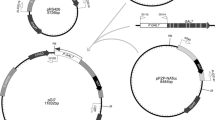Abstract.
Buchnera aphidicola, the endosymbiont of the aphid Schizaphis graminum, contains the gene ftsZ, which codes for a protein involved in the initiation of septum formation during cell division. With immunological techniques, this protein has been detected in cell-free extracts of the endosymbiont. Nucleotide sequence determination of a 6.4-kilobase B. aphidicola DNA fragment has indicated that, as in E. coli, ftsZ is adjacent to genes coding for other cell division proteins as well as genes involved in murein synthesis (murC–ddlB–ftsA–ftsZ). Although B. aphidicola ftsZ is expressed in E. coli, it cannot complement E. coli ftsZ mutants. High levels of B. aphidicola FtsZ results in the formation of long filamentous E. coli cells, suggesting that this protein interferes with cell division. The presence of FtsZ indicates that in this, as well as in many other previously described properties, B. aphidicola resembles free-living bacteria.
Similar content being viewed by others
Author information
Authors and Affiliations
Additional information
Received: 22 July 1997 / Accepted: 28 July 1997
Rights and permissions
About this article
Cite this article
Baumann, L., Baumann, P. Characterization of ftsZ, the Cell Division Gene of Buchnera aphidicola (Endosymbiont of Aphids) and Detection of the Product. Curr Microbiol 36, 85–89 (1998). https://doi.org/10.1007/s002849900284
Issue Date:
DOI: https://doi.org/10.1007/s002849900284




